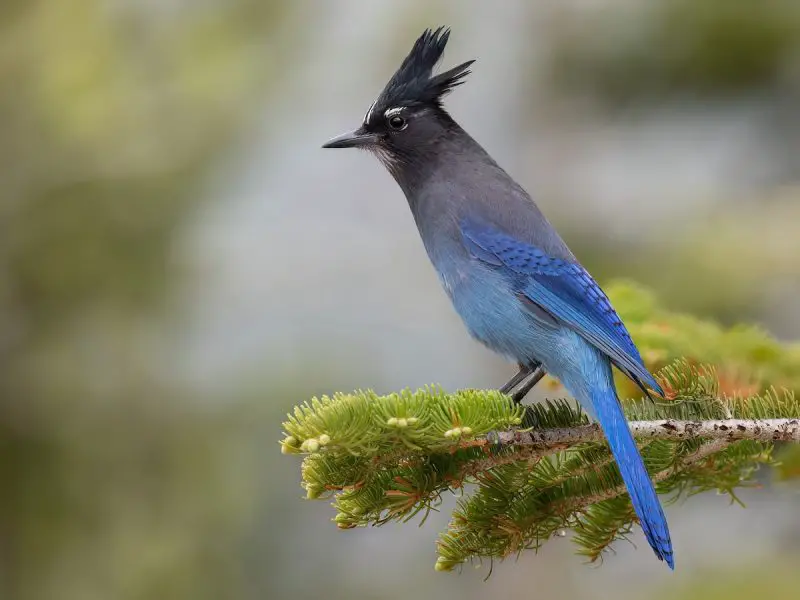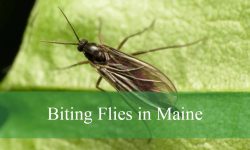New Mexico’s diverse landscapes—ranging from high mountain forests to arid desert woodlands—provide a perfect home for several species of jays. These intelligent, colorful birds are not only striking in appearance but also play vital roles in seed dispersal and forest health across the state.
Among the most common jays found here are the bold Steller’s Jay, the adaptable Woodhouse’s Scrub-Jay, the social Mexican Jay, and the flock-forming Pinyon Jay. Each of these species has unique traits that make them easy to identify and fascinating to observe in their native habitats.
In this guide, you’ll explore detailed identification tips, behavior, and the preferred environments of these four jay species in New Mexico—complete with pictures to help you recognize them in the wild.
Species of Jays Found in New Mexico
Steller’s Jay

The Steller’s Jay is a striking bird often seen in the forested highlands of northern and western New Mexico. It’s easily identified by its deep blue body and contrasting black head and crest, which forms a pointed mohawk. The bird’s upper body can sometimes have faint blue streaks, and its bright blue wings and tail make it stand out among conifer trees. Adult Steller’s Jays measure about 11.5 to 12.5 inches in length, with a wingspan of 17 inches, making them one of the larger jays in the region.
This species is known for its bold and curious behavior. Steller’s Jays are intelligent and vocal birds, often mimicking the calls of hawks or other birds to startle competitors away from food. They forage both on the ground and in trees, feeding on nuts, seeds, berries, insects, and occasionally bird eggs. They are also known to frequent picnic areas and campgrounds, especially in popular mountain parks such as the Sangre de Cristo or Sacramento Mountains.
In New Mexico, the Steller’s Jay prefers coniferous forests and mixed woodlands at elevations above 6,000 feet. It’s especially common in Ponderosa pine and Douglas fir habitats. The species is non-migratory in this state, staying in high-elevation forests year-round but occasionally descending to lower areas during winter in search of food.
Woodhouse’s Scrub-Jay

Woodhouse’s Scrub-Jay is a common and widely distributed jay in the arid and semi-arid landscapes of central and western New Mexico. This species has a light gray back, bright blue wings, tail, and head, with no crest and a pale throat outlined with a faint necklace of blue. It is slightly smaller than the Steller’s Jay, measuring about 11 inches in length with a wingspan of around 15 inches.
These jays are highly adaptable and intelligent, often seen in pairs or small groups. They are known for caching food like acorns and pine nuts in the ground, which helps them survive during the winter. Woodhouse’s Scrub-Jays are also very vocal, emitting scratchy “shreeenk” calls and various chatters when alarmed or communicating. They frequently visit feeders in rural or suburban areas where native shrubs and open woodlands exist.
In New Mexico, Woodhouse’s Scrub-Jay inhabits pinyon-juniper woodlands, scrubby hillsides, and canyon areas, particularly in the central and western parts of the state such as the Manzano Mountains and the Gila National Forest. It prefers drier environments and does not usually venture into dense forests or high elevations, favoring open, brushy habitats year-round.
Mexican Jay

The Mexican Jay is a social and cooperative bird found mainly in the remote mountainous areas of southern New Mexico. This jay is medium-sized, around 11.5 inches long, and is best recognized by its uniform pale blue color on the head, wings, and tail, with a lighter, grayish belly. Unlike many other jays, it lacks any crest, and its bill is dark and slightly thicker.
These birds are known for living in extended family groups and working together to defend territories and raise young. Mexican Jays are less vocal than other jays but still produce a variety of soft “chewk” or “queer” calls. They feed on insects, seeds, berries, and especially acorns. They often forage on the ground or low shrubs and are more elusive than urban jays, keeping close to their woodland habitats.
In New Mexico, the Mexican Jay is primarily found in the sky islands of the Peloncillo, Animas, and Chiricahua Mountains near the Arizona border. These jays favor oak-pine woodlands between 5,000 and 7,000 feet in elevation. Their range in the state is very limited, making sightings somewhat special for birders in southern New Mexico.
Pinyon Jay

The Pinyon Jay is a highly specialized species native to the dry pinyon-juniper woodlands of western and central New Mexico. It has a stocky build, short tail, and a long, pointed bill. Its plumage is dusty blue-gray overall, slightly paler on the belly and throat, with no crest and dark eyes. Adults are about 10 to 11 inches long and have a wingspan of approximately 18 inches.
These jays are highly gregarious, living in flocks that can number in the hundreds. Pinyon Jays are intelligent and excellent at storing seeds, especially pinyon pine seeds, which form the bulk of their diet. They rely heavily on good seed crops, and their population size can fluctuate based on pinyon pine productivity. Pinyon Jays are noisy and social, communicating with nasal “kaw-kaw” calls while foraging or flying.
In New Mexico, they are mostly found in the dry upland plateaus, including areas around the Jemez Mountains, Mount Taylor, and the Chaco Plateau. These birds prefer open pinyon-juniper woodlands and often avoid human settlements. Due to habitat degradation and changes in pinyon pine ecosystems, their numbers have declined in recent years, but they are still regularly observed in remote high desert regions.
FAQ about Jay Species in New Mexico
What types of Jays can be found in New Mexico?
New Mexico is home to four main species of jays: the Steller’s Jay, Woodhouse’s Scrub-Jay, Mexican Jay, and Pinyon Jay. Each of these species occupies different habitats across the state, from high mountain forests to dry desert woodlands.
Which Jay is the most common in New Mexico?
The Woodhouse’s Scrub-Jay is the most commonly seen jay in New Mexico. It thrives in pinyon-juniper woodlands, foothills, and semi-arid shrublands, and is often spotted in both wild and suburban areas.
Where can I see Steller’s Jays in New Mexico?
Steller’s Jays are found in the higher elevations of northern and western New Mexico, especially in coniferous forests. Popular locations include the Sangre de Cristo Mountains, the Santa Fe National Forest, and the Sacramento Mountains.
Are Mexican Jays found throughout New Mexico?
No, Mexican Jays are limited to the “sky island” mountain ranges in extreme southern New Mexico. They are typically found in oak-pine woodlands of the Peloncillo, Animas, and Chiricahua Mountains, close to the Arizona border.
What makes the Pinyon Jay unique among other jays in the state?
The Pinyon Jay is unique for its strong dependence on pinyon pine seeds. It is highly social, forming large flocks, and is most commonly found in the pinyon-juniper habitats of western and central New Mexico. Its nomadic behavior also sets it apart from more territorial jay species.
Do any Jay species migrate out of New Mexico?
Most jays in New Mexico are resident birds and do not migrate long distances. However, some species like the Pinyon Jay may move locally depending on food availability, especially during poor seed years.
Can I attract Jays to my backyard in New Mexico?
Yes, especially Woodhouse’s Scrub-Jays and occasionally Steller’s Jays if you live near forests. You can attract them with peanuts (unsalted), sunflower seeds, or suet. Providing native shrubs and trees will also make your yard more jay-friendly.
Are any Jay species declining in New Mexico?
Yes, the Pinyon Jay population has been declining due to habitat loss, climate change, and changes in pinyon pine ecosystems. Conservation efforts are ongoing to monitor and protect this species in New Mexico and throughout the Southwest.






